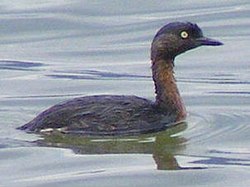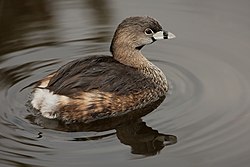| Common name | Binomial name | Population | Status | Trend | Notes | Image |
|---|
| Junin grebe | Podiceps taczanowskii | 140-320 [5] | EN [5] |  [5] [5] | Endemic to Lake Junín, Peru. [5] |  |
| Hooded grebe | Podiceps gallardoi | 650-800 [6] | CR [6] |  [6] [6] | Total population estimated at 3,000 – 5,000 in mid-1980s. [6] |  |
| Madagascar grebe | Tachybaptus pelzelnii | 1,000-2,499 [7] | EN [7] |  [7] [7] | |  |
| New Zealand grebe | Poliocephalus rufopectus | 1,000-5,000 [8] | LC [8] |  [8] [8] | Best estimate for breeding population is 2,000-4,000 individuals. [8] |  |
| Hoary-headed grebe | Poliocephalus poliocephalus | 16,600-670,000 [9] | LC [9] |  [9] [9] | Total population is estimated to be 25,000-1,000,000 individuals. [9] |  |
| Australasian grebe | Tachybaptus novaehollandiae | 16,800-687,000 [10] | LC [10] | ? [10] | Total population is estimated to be 25,203-1,031,000 individuals. [10] |  |
| Least grebe | Tachybaptus dominicus | 20,000-500,000 [11] | LC [11] |  [11] [11] | |  |
| Great grebe | Podiceps major | 26,700-93,300 [12] | LC [12] |  [12] [12] | Total population is estimated to be 40,000-140,000 individuals. [12] |  |
| Southern silvery grebe (Silvery grebe) | Podiceps occipitalis | 67,700-68,500 [13] | LC [13] |  [13] [13] | Note that IUCN/BirdLife International list the Northern silvery grebe (P. juninensis) as a separate species. Population has not been quantified, but it is listed as Near Threatened. [14] IOC retains this species as a subspecies within P. occipitalis. [1] |  |
| White-tufted grebe | Rollandia rolland | 68,800-70,100 [15] | LC [15] |  [15] [15] | Total population is estimated to be 103,250-105,200 individuals. [15] |  |
| Western grebe | Aechmophorus occidentalis | 80,000-90,000 [16] | LC [16] |  [16] [16] | |  |
| Clark's grebe | Aechmophorus clarkii | 81,000 [17] | LC [17] |  [17] [17] | |  |
| Red-necked grebe | Podiceps grisegena | 190,000-290,000 [18] | LC [18] |  [18] [18] | Values provided are an estimate of the total population. [18] |  |
| Horned grebe | Podiceps auritus | 239,000-583,000 [19] | VU [19] |  [19] [19] | Values provided are an estimate of the total population. [19] |  |
| Little grebe | Tachybaptus ruficollis | 384,000-2,350,000 [20] | LC [20] | ? [20] | Total population is estimated to be 575,997-3,525,996 individuals. [20] Note that the IOC has split the tricolored grebe from this species. [1] IUCN/BirdLife International maintain both species within T. ruficollis. [21] |  |
| Pied-billed grebe | Podilymbus podiceps | 500,000 [22] | LC [22] |  [22] [22] | |  |
| Great crested grebe | Podiceps cristatus | 609,999-997,000 [23] | LC [23] | ? [23] | Total population is estimated to be 915,000-1,400,000 individuals. [23] |  |
| Black-necked grebe | Podiceps nigricollis | 3,900,000-4,200,000 [24] | LC [24] | ? [24] | Values provided are an estimate of the total population. [24] |  |
|


















